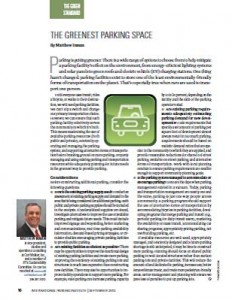Parking is getting greener. There is a wide range of options to choose from to help mitigate a parking facility’s effect on the environment, from energy-efficient lighting systems and solar panels to green roofs and electric vehicle (EV) charging stations. One thing hasn’t changed: parking facilities exist to store one of the least environmentally-friendly forms of transportation on the planet. That’s especially true when cars are used to transport one person.
Until everyone uses transit, rides a bicycle, or walks to their destination, we will need parking facilities. We can’t flip a switch and change our primary transportation choice. However, we can ensure that each parking facility effectively serves the community in which it’s built. This means maximizing the use of available parking resources (both public and private), efficiently operating and managing the parking system, and supporting alternative forms of transportation before breaking ground on more parking. Properly managing and using existing parking and transportation resources while adequately planning for future needs is the greenest way to provide parking.
Considerations
Before constructing additional parking, consider the following questions:
How is the existing parking supply used? Conduct an assessment of existing parking supply and demand in the area that is being considered for additional parking. Both public and private parking supplies should be included in the analysis. If underutilized supplies are found, investigate alternatives to improve the use of available parking and mitigate future needs. This could include improved signage and wayfinding, better marketing and communications, real-time parking availability information, demand-based pricing strategies, or circulator shuttles encouraging private parking facilities to provide public parking.
Are existing facilities as efficient as possible? There may be opportunities to improve the functional design of existing parking facilities and create more parking. Improving the efficiency of existing parking lots and structures is much less expensive than constructing new facilities. There may also be opportunities to improve facility operations to support more parking. For example, valet parking can increase parking capacity by 10 to 30 percent, depending on the facility and the skill of the parking operator’s staff.
Are existing parking requirements adequately estimating parking demand for new developments? Code requirements that specify a set amount of parking per square foot of development almost always result in too much parking. Requirements should be based on realistic demand ratios that are specific to the community in which they are applied, and provide reasonable reductions for shared off-street parking, available on-street parking, and alternative forms of transportation. Work with local planning officials to ensure parking requirements are flexible enough to support community planning goals.
Is the parking system managed to accommodate or encourage parking? Gone are the days when parking management existed in a vacuum. Today, parking and transportation management are nearly one and the same; parking is just one way people access a community. A parking program should support the use of alternative forms of transportation by accommodating bicycles in parking facilities, developing programs that merge parking and transit (e.g., periodic parking for daily transit users), marketing the availability of mass transit, accommodating car sharing programs, appropriately pricing parking, not overbuilding parking, etc.
If available resources are well-used, appropriately managed, and efficiently designed and a future parking shortage is still anticipated, it may be time to construct more parking. Planning should focus on shared public parking in well-located structures rather than surface parking lots and private facilities. This will reduce the amount of land dedicated to parking, increase use, better focus vehicular traffic, and create more pedestrian-friendly areas. Better management and planning will ensure we pave less of paradise to put up parking lots.
Matthew Inman is vice president, studies and operations consulting at Carl Walker, Inc., and a member of IPI’s Sustainability Committee. He can be reached at minman@carlwalker.com or 269.381.2222.
TPP-2013-09-The Greenest Parking Space

